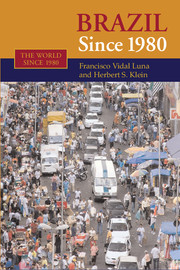Book contents
8 - Inequality: Class, Residence, and Race
Published online by Cambridge University Press: 03 June 2010
Summary
By whatever criteria used, Brazil is one of the most unjust societies in the world. This statement is even more true when we consider just the industrial countries. None of these countries presents indicators of inequality similar to Brazil. In 2001 the top 10 percent of the population controlled 50 percent of the wealth and the bottom 50 percent accounted for just 12 percent of all salaried income. How severe this distortion is can be seen from comparable data for Canada in 2000. There, the top 10 percent of the population accounted for only a quarter of the national wealth and the poorest 50 percent for 28 percent. In a typical Scandinavian country such as Sweden in 2000, the richest deciles controlled just 22 percent of the wealth and the poorest half accounted for 32 percent of wealth. Brazil by the usual GINI indices of inequality shows an index number in the upper 50s and lower 60s, compared to mid- to high 50s for most Latin American countries, and an index in the 30s to lower 40s for most advanced industrial countries. It has been estimated that by world standards Brazilian per capita income should result in a 10 percent ratio of poor in the national population. In fact, 34 percent of the Brazilian population was considered poor in 1999 – some fifty-four million persons, of whom twenty-two million were considered indigent.
- Type
- Chapter
- Information
- Brazil since 1980 , pp. 209 - 235Publisher: Cambridge University PressPrint publication year: 2006



